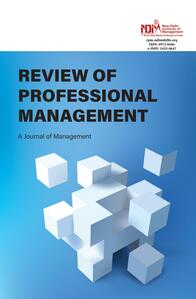
1Loyola College of Social Sciences, University of Kerala, Thiruvananthapuram, Kerala, India

Creative Commons Non Commercial CC BY-NC: This article is distributed under the terms of the Creative Commons Attribution-NonCommercial 4.0 License (http://www.creativecommons.org/licenses/by-nc/4.0/) which permits non-Commercial use, reproduction and distribution of the work without further permission provided the original work is attributed.
Today’s dynamic business world demands a shift from traditional HR practices to a more balanced HR system, integrating environmental, social and economic concerns. Termed as sustainable human resource management (SHRM), it is concerned with helping the organisation perform better while maintaining ecological parameters and ensuring the well-being of employees and the community. This article uses a systematic review of publications on SHRM to analyse the level of integration of the triple bottom line (TBL) into its philosophy. The article also contributes to the HR literature by consolidating the new roles of the HR team in an organisation to implement SHRM practices judiciously. This article proposes a model that integrates SHRM, HR roles and the TBL to achieve organisational sustainability.
ESG, sustainable HRM, triple bottom line, organisational sustainability, HR roles
Introduction
In the contemporary business landscape, organisations increasingly recognise the need for a sustainable approach to management and its functional areas, such as human resource management (HRM). Reflecting upon the emerging trends, Sharma (2024) summarised that sustainability has its focus on innovation, systemic change, accountability and leadership. It was observed that the new sustainability reporting frameworks led to greater accountability in organisations by an enhanced integration of sustainability into core business strategies, focusing on environmental and social responsibility.
Sustainable HRM (SHRM) as a concept first appeared at the onset of the new millennium (Kainzbauer et al., 2021). Initial discussions were held in countries such as Germany, Switzerland and Australia. Zaugg et al. (2001), Gollan (2000) and Wilkinson et al. (2001) were the main contributors to this concept. The conceptualisation of SHRM by Müller-Christ and Remer (1999) emphasised that the sustainable management of people has lasting access to qualified human resources. A broader definition was proposed by Zaugg et al. (2001), who explained this as methodological and instrumental approaches with the purpose of long-standing, equitable and economically efficient recruitment, training and employee retention.
While Elkington (1994) introduced the concept of triple bottom line (TBL) integrating three dimensions, namely, profit, people and planet, it is Cohen et al. (2012) who brought the TBL perspective to HRM. They considered the goal of SHRM to be ensuring the lasting survival of the organisation’s stakeholders, with policies reflecting justice, progress and happiness, and supporting eco-friendly practices. Concurrently, the HRM field has undergone a transformative shift towards sustainability, recognising the pivotal role of human capital in achieving long-term viability and performance. Subsequently, many typologies have emerged on the sustainability dimension of HRM. These include corporate social responsibility (CSR), green HRM and TBL HRM. An emerging paradigm of sustainability is the ESG (environmental, social and governance) framework.
Authors like Kramar (2014) and Ehnert et al. (2016) have contributed to a more strategic focus of TBL goals. Focusing on the organisational outcomes and stakeholders’ expectations, Järlström et al. (2016) adopted a TBL perspective on SHRM. While Cohen et al. (2012) focused on social responsibility, many others, like Bombiak and Marciniuk-Kluska (2018), highlighted HRM’s environmental dimension, popularly known as green HRM. There are also usages like sustainable work systems and sustainable leadership (Avery, 2005). Scholars like Jackson et al. (2011) have integrated TBL in the HRM context, proposing the concept of ‘triple bottom line HRM’. The same is true for the predominant conceptualisation of SHRM (Kramar, 2014), which seems to be more popular than the former. One of the related conceptualisations by Aust et al. (2020) is common good HRM, which is defined as orienting a firm towards using its resources toward resolving the ‘grand challenges of our time’ and prioritising an organisation’s contribution to environmental and societal transition. In addition, some of the writings (Avery & Bergsteiner, 2010; Benn et al., 2007; Mariappanadar, 2012) acknowledged a rising apprehension about the impact of HRM policies on external dimensions, including environmental, social and human aspects of society. Some other studies reported the influence of HRM practices on employees (Jackson et al., 2011) and customers (Kramar, 2014).
Subsequently, there has been a substantial change in the role of HR professionals in organisations. As their role has changed to that of an organisational business partner, there is a greater realisation of the contribution of HRM systems and practices to sustainability initiatives. This happened mainly due to the increasing priority of sustainability among stakeholders like customers, communities, governments and civil society organisations.
Research Problem
The scope of sustainability initiatives has moved far from CSR to a new level of corporate sustainability. The emergence of a SHRM framework is a response to such a paradigm shift, which integrates the social, environmental, governance and economic dimensions of HRM practice. In addition, SHRM involves the integration of the TBL philosophy into the practice of HRM in organisations. Authors like Westerman et al. (2020) emphasised the need for HRM involvement in navigating the transition of business goals from mere economic focus to a multi-stakeholder TBL perspective. Studying SMEs, Purga-Popiela (2024) observed mounting attention on sustainable HR practices post-2020. It highlighted the inadequate devotion to the TBL perspective while acknowledging the worthwhile effects of SHRM practices on employee competencies, behaviours and organisation-level outcomes. Although Stahl et al. (2020) acknowledged the role of HRM in supporting a firm’s CS/CSR efforts, they contended that it has failed to deliver this effectively. A document analysis by Kainzbauer et al. (2021) showed that the evolving literature on SHRM is profoundly skewed toward ecological concerns. According to Anlesinya and Susomrith (2020) there is an over-concentration of the ecological perspective of SHRM. Piwowar-Sulej (2021) also supported this. Another systematic review by Macke and Genari (2019) showed that 29% of reviews focused on the ecological aspect of HRM, 19 percent on the economic and 44% on the social element. Amrutha and Geetha (2020) also found that social sustainability was a less-researched area compared to economic and green dimensions of sustainability. The results of Sayyadi et al. (2017) indicated that the environmental dimension was one of the effective factors of sustainability. In a study, Cerutti et al. (2023) evaluated the relationship between sustainable leadership factors and employee retention in Brazilian firms. According to the study, the economic aspect explained 27.60% of sustainability, while the social and environmental parameters explained 25.54% and 20.27%, respectively.
Naseer et al. (2023) argued that green HRM positively influences the TBL. Findings by Alwan and Al-Hisnawi (2023) concluded that sustainable HR strategies cover several key HR practices. They observed that organisations could take advantage of implementing green HRM measures and promoting sustainable HR practices to augment organisational performance and social accountability. A study by Rajhans and Bhavsar (2023) also indicated that SHRM practices, CSR, and the financial performance of organisations are strongly correlated. Gupta (2017) explained the role of CSR in promoting SHRM practices in Reliance Industries Ltd. The author highlighted the role of SHRM practices as cost saving, risk reduction, enhanced reputation and employer branding. This article attempted to link recruitment and retention, training and career development and health and well-being as critical HR practices to ensure the sustainability of organisations.
Based on a systematic review, Saini et al. (2022) proposed a conceptual framework that consolidated 19 factors constituting the TBL dimensions. Westerman et al. (2020) also analysed articles covering the SHRM model with TBL perspective. Zaid et al. (2018) also established that green HRM practices positively affect the TBL of sustainability performance.
A critical review of research on SHRM reveals that this topic is in its progressive stage. Content-wise, most of these studies were limited to assessing the impact of SHRM on organisational outcomes and employee behaviours. Methodologically, many studies have adopted bibliometric analysis and systematic literature reviews. However, studies connecting SHRM and TBL philosophy appear to be limited. The role of HRM in SHRM practices is another grey area. This article is an attempt to explore this research gap. It attempts to provide a comprehensive and scientific discussion on the various dimensions of the TBL from the sustainability perspective of HRM practices. It explores the dynamics of TBL principles and HRM, investigating how integration can contribute to sustainable organisational practices. Hence, after considering the various typologies of the TBL and SHRM in the introductory section, this article focuses on the following research objectives in the subsequent sections:
Research Methods
This article adopted bibliometric analysis in the initial phase, which is augmented through content analysis in the latter phase. The publication data for this article were collected from the Scopus database and were published in English from 2000 to 2024 (upto September). The year 2000 was fixed because the concept of SHRM was reflected in the literature during this time. The authors used keywords such as TBL and SHRM, economic dimension and SHRM, social dimension and SHRM, and environment and SHRM. The initial search resulted in a total of 231 records. These records were downloaded as a CSV file, including data on all the fields like authors, article title, year, source title, volume, issue, pages, cited by, DOI, link, authors’ affiliation, abstract, keywords, publisher and ISSN/ISBN. All the research papers, conference proceedings and book chapters meeting the search criteria were included. These records revealed that many generic papers are irrelevant to the HRM context. These include papers on the sustainability of processes and products from a purely operational perspective, which is unrelated to HRM practice. Hence, these records were deleted from the database, resulting in refined data from 157 records. These data were used as input for the analysis through VOSviewer software.
In Stage 2, a content analysis of the 157 papers retrieved in the bibliometric analysis was performed to meet the objectives of this study, such as the integration of the TBL in SHRM (see Table 1). The thematic analysis of the data was adequately supplemented by the bibliometric patterns identified in the first stage. For example, after identifying the ten most cited papers, a detailed content analysis was performed to review the main focus and themes discussed in each of these papers to corroborate the central propositions. A similar approach is followed to address the other areas of exploration in this article.
Table 1. Strategy Used for the Bibliometric Data Search.
.jpg/10_1177_09728686251384393-table1(1)__480x239.jpg)
Results
Results of the Bibliometric Analysis
The following section presents the results of the analysis of the data collected for the bibliometric data.
Number of Publications
Figure 1 presents the year-wise details of the publications, with a total of 157 publications reported.
Figure 1. Year-wise Publications (%).
.jpg/10_1177_09728686251384393-fig1(1)__480x268.jpg)
Source: VOSviewer.
Note: *2024 data up to September only.
The trend is clear from Figure 1. Although SHRM emerged at the beginning of the millennium, publications in this area became prominent only in 2008, and there was a substantial increase in publications from 2019 onwards; more than 83% of the publications happened after 2019. This shows a growing interest in sustainability in HRM after 2019.
Number of Citations
Figure 2 gives the year-wise citations (given in %).
It is clear from Figure 2 that nearly one-fourth (24.36%) of the citations were published in 2022, followed by 15.41% in 2019. The total of these two years comes to (39.77%) of the total citations (4236). Therefore, a resurgence in publications and citations of SHRM was visible in the post-2018 period.
Figure 2. Year-wise Citations.

Source: VOSviewer.
Most Cited Papers
To obtain in-depth insight into the themes covered in the most cited papers, the authors have undertaken a content analysis, and the following is a description based on the thematic analysis (see Figure 3). The most cited article is ‘Beyond Strategic Human Resource Management: Is Sustainable Human Resource Management the Next Approach?’ which was published in 2014 in the International Journal of Human Resource Management and authored by Kramar.
Figure 3. Most Cited Papers.

Source: VOSviewer.
The focus of the most cited paper was the features of SHRM by acknowledging organisational outcomes beyond financial ones. This article also categorised the outcomes of sustainable HR practices into three, namely capacity restoration, enhancing social and environmental health, and promoting networks. The emphasis was on the transition from strategic HRM to SHRM.
In the second most cited paper, Zaid et al. (2018) concluded that green HRM positively affects TBL of sustainability performance. The third in the list of most cited papers is by Jabbour and Santos (2008), who detailed how HRM practices contribute to TBL dimensions in organisations. The next paper is a systematic literature review by Macke and Genari (2019) on SHRM. They classified reviews into four categories: sustainable leadership, the relationship among HRM, environmental sustainability and organisational performance, conflicts between HRM and sustainability, and, finally, the linkage between HRM and the social pillar of sustainability. It was concluded that, beyond the TBL concept, leadership is an important factor influencing SHRM.
The fifth paper in the list is also a systematic review by Amrutha and Geetha (2020), who analysed the mediating role of green employee behaviour in green HRM practices and organisational sustainability linkages. They concluded that social sustainability is the least attended area compared to sustainability’s economic and environmental pillars. By examining the key role of SHRM in maintaining a sustainable workplace and enabling the attainment of SDGs, Chams and García-Blandón (2019) identified the antecedents of SHRM as green behaviours, green competencies and green values. They also listed the outcomes of SHRM.
Among the remaining most cited papers, Davidescu et al. (2020) investigated the links among employee development, work timing and workplace flexibility as pertinent features of SHRM. The focus of the paper by Stahl et al. (2020) was the role of HRM in contributing to a firm’s CS/CSR efforts. The authors identified the TBL domains of SHRM. Through qualitative analysis, Järlström et al. (2018) revealed four domains of SHRM: ‘justice and equality, transparent HR practices, profitability and employee well-being’. They provided a discussion of the roles played by diverse stakeholders like owners, managers, employees, customers and employee representatives in implementing SHRM. The last in the list of the ten most cited papers is by Stankevi.png) i
i.png) t
t.png) and Savanevi
and Savanevi.png) ien
ien.png) (2018), who highlighted the characteristics of SHRM. Considering the emphasis on the three dimensions of the TBL, four of these papers covered all three dimensions, while another four papers discussed the green dimension alone. One paper mentioned social and environmental aspects.
(2018), who highlighted the characteristics of SHRM. Considering the emphasis on the three dimensions of the TBL, four of these papers covered all three dimensions, while another four papers discussed the green dimension alone. One paper mentioned social and environmental aspects.
Citation by Source
Figure 4 shows that the top two cited journals are Sustainability and the Journal of Cleaner Production, which are more connected with the discipline of environmental science.
Figure 4. Citation by Sources.

Source: VOSviewer.
The third most cited journal is the International Journal of Human Resource Management. It was also found that more than 50% of the top-cited journals are related to business or social sciences, whereas the rest are related to environmental or sustainability disciplines.
A source-wise citation map was created from the VOS Viewer software, which allows the generation of a visualisation map of the most cited journals (refer Figure 5).
Figure 5. Citation Map-source.
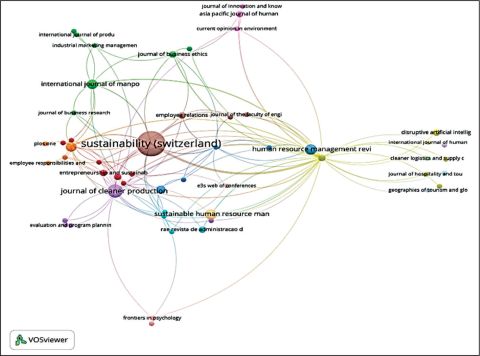
Source: VOSviewer.
Top-cited Author
The most cited single author is Kramar (2014). Another three coauthors who received the second most citations are Jaaron, Talib and Zaid (see Figure 6). This was followed by Santos and Jabbour. This also reveals that the authors treat the concept of sustainability in HRM with an inclination toward the environmental dimension.
Figure 6. Citation map-author.
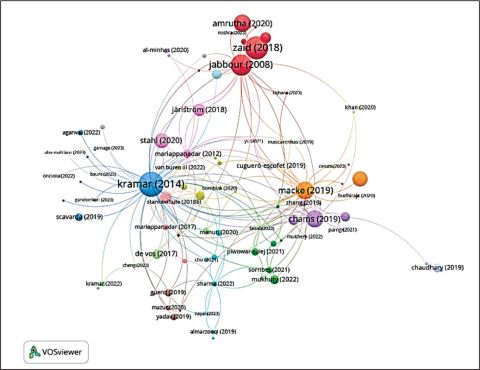
Source: VOSviewer.
Citation Network-countries
Figure 7 displays the citation network among the top 26 nations. Australia is the country with the most articles cited, followed by India, Spain and Malaysia.
Figure 7. Citation Network-countries.
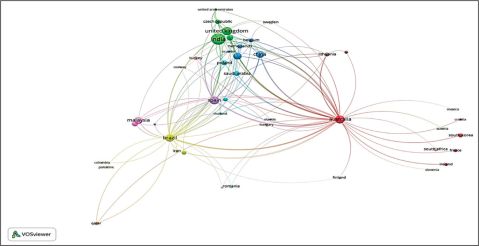
Source: VOSviewer.
Bibliographic Coupling Countries
It is evident from the map that the intellectual structure between India and the UK is strong and the same, although the number of authorships per country is different (see Figure 8). There are eight countries in this cluster. The green cluster covers nine countries with a larger number of authorships from Australia, while the red cluster consists of 15 countries. The yellow cluster has six countries.
Figure 8. Bibliographic Coupling Countries.
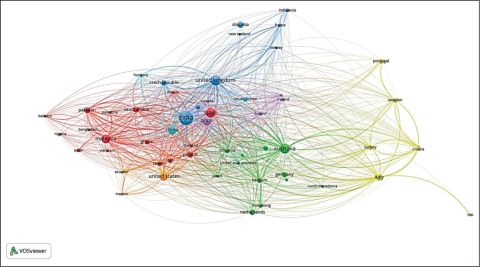
Source: VOSviewer.
Results of the Content and Thematic Analysis
Table 2 presents the consolidated versions of the themes related to the TBL as covered in the bibliometric data. The keyword analysis was manually performed via Excel and SPSS software. The first three columns of the table give the keywords exclusively covering the three dimensions of the TBL, such as social, economic and, while the last column gives the combinations of keywords related to the TBL dimensions and general sustainability focus covered in the publications.
Table 2. Triple Bottom Line and SHRM—Keyword Analysis.
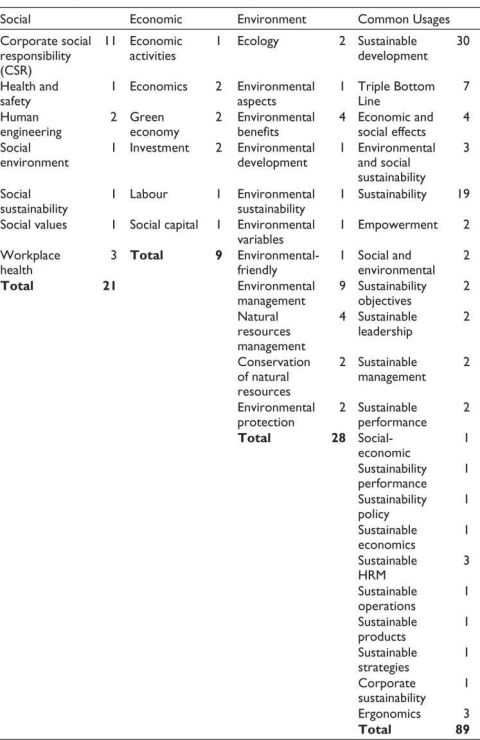
Source: Consolidated by the authors from bibliometric data.
The table indicates the predominance of ecological or green dimensions in the literature on SHRM. Although social aspects have also received considerable attention, economic dimensions are still poorly covered in the keywords. Many other terms are used in publications to refer to sustainability, including integrating more than one dimension of the TBL.
SHRM and Organisational Outcomes
One focus area identified through the content analysis of the SHRM literature is the organisational impact of the practice of SHRM. Table 3 gives the gist of the studies in this regard.
Table 3. Organisational Outcomes of Sustainable HRM.
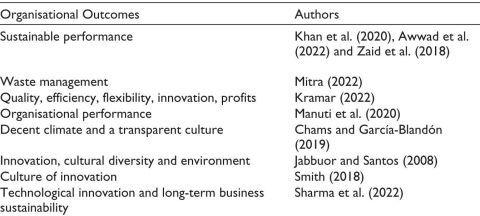
Five papers refer to performance enhancement as the outcome in the publications retrieved, and different terms, such as sustainable performance (three papers), organisational performance and financial performance, were used to indicate this. Another dominant organisational outcome was innovation, which was found in three papers, as shown in Table 3.
SHRM and Employee Behaviours
Another focus area identified through the content analysis was employee behaviour manifestations as a result of SHRM practices. This is based on a thorough review of these papers by the authors to understand the interdynamics of SHRM and employee behaviours.
It is evident from the Table 4 that SHRM practices induce greater employee satisfaction, as reflected in five papers. The other major employee behaviours included OCB, commitment, well-being, enhancing competencies and bonding with the organisation.
Table 4. Employee Behaviours as a Result of Sustainability in HRM.
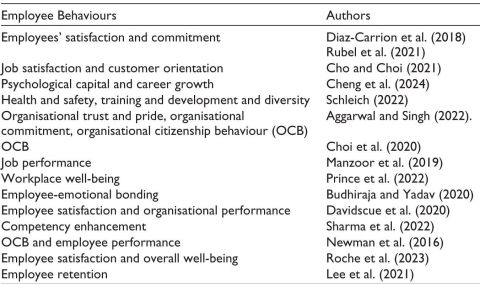
Discussions
This section covers the findings that emerged from the analysis, along with some pragmatic suggestions. There is a growing recognition of sustainability concerns in the publications covered in this study. This is expressed in different typologies, namely, environmental sustainability, sustainable leadership, sustainable management, sustainable performance and corporate sustainability. Two major arguments were proposed based on the analysis:
Future Directions: Role of HR Managers in SHRM
The reviews reveal that the role of HR managers in implementing SHRM practices is one of the least explored areas. One of the noteworthy contributions is a systematic literature review by Podgorodnichenko et al. (2020), who proposed three major HRM roles related to sustainability, namely, strategic support, employee advocacy and social support.
Inspired by this work, the authors propose a detailed set of roles useful for integrating sustainability in the practice of HRM in organisations. Practising the following roles will help HR professionals better address TBL concerns in their HR practices.
Figure 9 presents a model that synthesises the interplay of the triple bottom-line dimensions of sustainability with HR roles to achieve organisational sustainability. The five major HR roles to be played by HR professionals to achieve sustainability in HR practices are visualised in this model. The expected outcome of this framework is to emphasise the comprehensive role of the HR team in organisations by integrating the three dimensions of TBL to achieve organisational sustainability through enhanced employee behaviours and positive organisational outcomes.
Figure 9. Proposed Model for Sustainable HRM.
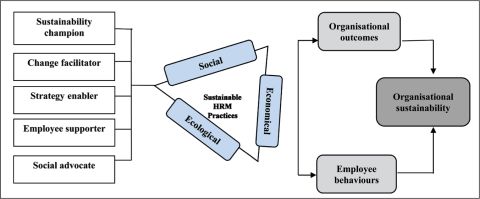
Conclusion
This study provides a scientific analysis of the literature on SHRM. Sustainability perspectives have gained momentum in scientific publications over the last three years. However, the concept of sustainability, especially from an HRM perspective, requires a more comprehensive understanding. As shown by the findings of this article, the environment dimension still dominates from the sustainability perspective of HRM. According to a TBL paradigm, the economic and social dimensions need more integration in HRM practices. This demands that HRM practitioners play a different set of roles, which will help the stakeholders in the organisation have meaningful work and life.
Declaration of Conflicting Interests
The authors declared no potential conflicts of interest with respect to the research, authorship and/or publication of this article.
Funding
The authors received no financial support for the research, authorship and/or publication of this article.
ORCID iD
Ranjit I. George  https://orcid.org/0000-0001-6094-3682
https://orcid.org/0000-0001-6094-3682
Aggarwal, P., & Singh, R. K. (2022). Synthesizing the affinity between employees’ internal–external CSR perceptions and work outcomes: A meta‐analytic investigation. Business Ethics, the Environment & Responsibility, 31(4), 1053–1101.
Alwan, B. M., & Al-Hisnawi, S. M. (2023). Analysis of sustainable human resources response to the impact of green human resources management strategies: Analytical exploratory research for the opinions of a sample of university leaders and technical teaching staff. Migration Letters, 20(S5), 93–108.
Amrutha, V. N., & Geetha, S. N. (2020). A systematic review on green human resource management: Implications for social sustainability. Journal of Cleaner Production, 247, 119–131.
Anlesinya, A., & Susomrith, P. (2020). Sustainable human resource management: A systematic review of a developing field. Journal of Global Responsibility, 11(3), 295–324.
Aust, I., Matthews, B., & Muller-Camen, M. (2020). Common good HRM: A paradigm shift in sustainable HRM? Human Resource Management Review, 30(3). https://doi.org/10.1016/6/j.hrmr.2019.100705
Avery, G. (2005). Leadership for sustainable futures: Achieving success in a competitive world. Edward Elgar Publishing.
Avery, G. C., & Bergsteiner, H. (2010). Honeybees & locusts: The business case for sustainable leadership. Allen & Unwin.
Awwad Al-Shammari, A. S., Alshammrei, S., Nawaz, N., & Tayyab, M. (2022). Green human resource management and sustainable performance with the mediating role of green innovation: A perspective of new technological era. Frontiers in Environmental Science, 10, 901235. https://doi.org/10.3389/fenvs.2022.901235
Benn, S., Griffiths, A., & Dunphy, D. (2007). Organizational change for corporate sustainability: A guide for leaders and change agents of the future. Routledge.
Bombiak, E., & Marciniuk-Kluska, A. (2018). Green human resource management as a tool for the sustainable development of enterprises: Polish young company experience. Sustainability, 10(6), 1739.
Budhiraja, S., & Yadav, S. (2020). Employer branding and employee-emotional bonding—The CSR way to sustainable HRM. In Sustainable human resource management: Transforming organizations, societies and environment (pp. 133–149). Springer. https://doi.org/10.1007/978-981-15-5656-2_8
Cerutti, P. S., Sarate, J. A. R., & Macke, J. (2023). Organisational leadership for sustainability: Employees’ perception of talent retention. International Journal of Innovation and Sustainable Development, 17(4), 425–446.
Chams, N., & García-Blandón, J. (2019). On the importance of sustainable human resource management for the adoption of sustainable development goals. Resources, Conservation and Recycling, 141, 109–122. https://doi.org/10.1111/1744-7941.12371
Cheng, B., Yu, X., Dong, Y., & Zhong, C. (2024). Promoting employee career growth: The benefits of sustainable human resource management. Asia Pacific Journal of Human Resources, 62(1). https://doi.org/10.1111/1744-7941.12371
Cho, Y., & Choi, Y. (2021). When and how does sustainable HRM improve customer orientation of frontline employees? Satisfaction, empowerment, and communication. Sustainability, 13(7), 3693.
Choi, J., Sohn, Y. W., & Lee, S. (2020). The effect of corporate social responsibility on employees’ organizational citizenship behaviour: A moderated mediation model of grit and meaning orientation. Sustainability, 12(13). https://doi.org/10.3390/su12135411
Cohen, E., Taylor, S., & Muller-Camen, M. (2012). HRM’s role in corporate social and environmental sustainability [SHRM Foundation’s Effective Practice Guidelines Series]. SHRM. Retrieved, 10 December 2023, from https://www.shrm.org
Davidescu, A. A., Apostu, S. A., Paul, A., & Casuneanu, I. (2020). Work flexibility, job satisfaction, and job performance among Romanian employees—Implications for sustainable human resource management. Sustainability, 12(15). https://doi.org/10.3390/su12156086
Diaz‐Carrion, R., López‐Fernández, M., & Romero‐Fernandez, P. M. (2018). Developing a sustainable HRM system from a contextual perspective. Corporate Social Responsibility and Environmental Management, 25(6), 1143–1153.
Ehnert, I., Parsa, S., Roper, I., Wagner, M., & Muller-Camen, M. (2016). Reporting on sustainability and HRM: A comparative study of sustainability reporting practices by the world’s largest companies. The International Journal of Human Resource Management, 27(1), 88–108.
Elkington, J. (1994). Towards the sustainable corporation: Win-win-win business strategies for sustainable development. California Management Review, 36(2), 90–100.
Gollan, P. J. (2000). Human resources, capabilities and sustainability. In D. Dunphy, J. Benveniste, A. Griffiths, & P. Sutton (Eds.), Sustainability: The corporate challenge of the 21st century (pp. 55–77). Allen & Unwin.
Gupta, M. (2017). Corporate social responsibility: Ensuring sustainable human resource management practices. Review of Professional Management, 15(1), 78–83. https://doi.org/10.20968/rpm/2017/v15/i1/151693
Jabbour, C. J. C., & Santos, F. C. A. (2008). The central role of human resource management in the search for sustainable organizations. The International Journal of Human Resource Management, 19(12), 2133–2154. https://doi.org/10.1080/09585190802479389
Jackson, S. E., Renwick, D. W., Jabbour, C. J., & Muller-Camen, M. (2011). State-of-the-art and future directions for green human resource management: Introduction to the special issue. German Journal of Human Resource Management, 25(2), 99–116.
Järlström, M., Saru, E., & Vanhala, S. (2018). Sustainable human resource management with salience of stakeholders: A top management perspective. Journal of Business Ethics, 152(3), 703–724. http://dx.doi.org/10.1007/s10551-016-3310-8
Kainzbauer, A., Rungruang, P., & Hallinger, P. (2021). How does research on sustainable human resource management contribute to corporate sustainability? A document co-citation analysis, 1982–2021. Sustainability, 13(21), 11895.
Kramar, R. (2014). Beyond strategic human resource management: Is sustainable human resource management the next approach? The International Journal of Human Resource Management, 25(8), 1069–1089.
Kramar, R. (2022). Sustainable human resource management: Six defining characteristics. Asia Pacific Journal of Human Resources, 60(1), 146–170. https://doi.org/10.1111/1744-7941.12321
Macke, J., & Genari, D. (2019). Systematic literature review on sustainable human resource management. Journal of Cleaner Production, 208, 806–815. https://doi.org/10.1016/j.jclepro.2018.10.091
Manuti, A., Giancaspro, M. L., Molino, M., Ingusci, E., Russo, V., Signore, F., Zito, M., & Cortese, C. G. (2020). “Everything will be fine”: A study on the relationship between employees’ perception of sustainable HRM practices and positive organizational behaviour during COVID-19. Sustainability, 12(23). https://doi.org/10.3390/su122310216
Manzoor, F., Wei, L., Bányai, T., Nurunnabi, M., & Subhan, Q. A. (2019). An examination of sustainable HRM practices on job performance: An application of training as a moderator. Sustainability, 11(8). https://doi.org/10.3390/su11082263.
Mariappanadar, S. (2012). The harm indicators of negative externality of efficiency focused organizational practices. International Journal of Social Economics, 39(3), 209–220.
Mitra, S. (2022). An exploratory study of sustainability and firm performance for Indian manufacturing small and medium enterprises. Journal of Cleaner Production, 371. https://doi.org/10.1016/j.jclepro.2022.133705
Müller-Christ, G., & Remer, A. (1999). Environmental economics or business ecology? Preliminary thoughts on a theory of resource management. In Operational environmental management in the 21st century: Aspects, tasks, perspectives (pp. 69–87). Springer.
Naseer, M., Asad, N., Hashmi, H. B. A., Fu, H., & Abbass, K. (2023). Analysing the pro-environmental behaviour of pharmaceutical employees through green HRM practices: The mediating role of green commitment. Environmental Science and Pollution Research, 30(3), 7886–7903.
Newman, A., Miao, Q., Hofman, P. S., & Zhu, C. J. (2016). The impact of socially responsible human resource management on employees’ organizational citizenship behaviour: The mediating role of organizational identification. The International Journal of Human Resource Management, 27(4), 440–455.
Piwowar‐Sulej, K. (2021). Core functions of sustainable human resource management: A hybrid literature review with the use of H‐classics methodology. Sustainable Development, 29(4), 671–693. https://doi.org/10.1002/sd.2166
Podgorodnichenko, N., Edgar, F., Akmal, A., & McAndrew, I. (2021). Sustainability through sensemaking: Human resource professionals’ engagement and enactment of corporate social responsibility. Journal of Cleaner Production, 293. https://doi.org/10.1016/j.jclepro.2021.126150
Podgorodnichenko, N., Edgar, F., & McAndrew, I. (2020). The role of HRM in developing sustainable organizations: Contemporary challenges and contradictions. Human Resource Management Review, 30(3). https://doi.org/10.1016/j.hrmr.2019.04.001
Prince, R., Vihari, N. S., & Rao, M. K. (2022). Examining the effects of sustainable HRM on work well-being: The role of voice behaviour and trust in management. In Managing risk and decision making in times of economic distress (Part B, pp. 159–171). Emerald Publishing.
Proença, T. (2022). Sustainability and the role of HRM. Revista de Administração de Empresas, 62(5).
Purgał-Popiela, J. (2024). Sustainability in human resource management practices used by small and medium-sized enterprises: A systematic review. Central European Management Journal. https://doi.org/10.1108/CEMJ-03-2024-0097
Rajhans, K., & Bhavsar, V. (2023). Impending need of sustainable human resource management practices in construction industry: Evidence from India. International Journal of Construction Management, 23(13), 2249–2259.
Roche, M., Shang, S., Bentley, T., Catley, B., Blackwood, K., Teo, S., & Sutton, A. (2023). Mindfulness, older workers, and relational leadership. Journal of Management & Organization, 29(3), 571–588.
Rubel, M. R. B., Kee, D. M. H., & Rimi, N. N. (2021). The influence of green HRM practices on green service behaviours: The mediating effect of green knowledge sharing. Employee Relations: The International Journal, 43(5), 996–1015.
Saini, S., Sachdeva, L., & Badhotiya, G. K. (2022). Sustainable human resource management: A conceptual framework. SPAST Abstracts, 1(01). https://spast.org/techrep/article/view/3417
Sayyadi, T. H., Azadi, M. H., & Sayyahpoor, A. (2017). Analysing factors affecting implementation success of sustainable human resource management (SHRM) using a hybrid approach of FAHP and type-2 fuzzy DEMATEL. Journal of Cleaner Production. https://doi.org/10.1016/j.jclepro.2017.06.109
Schleich, M. V. (2022). What are the human resources policies and practices most used by companies with the best ESG ratios in Brazil? Revista de Administração de Empresas, 62. http://dx.doi.org/10.1590/S0034-759020220511x
Schotten, M., Meester, W. J., Steiginga, S., & Ross, C. A. (2017). A brief history of Scopus: The world’s largest abstract and citation database of scientific literature. In Research analytics (pp. 31–58). Auerbach Publications.
Sharma, M., Luthra, S., Joshi, S., & Kumar, A. (2022). Analysing the impact of sustainable human resource management practices and industry 4.0 technologies adoption on employability skills. International Journal of Manpower, 43(2), 463–485. https://doi.org/10.1108/IJM-02-2021-0085
Sharma, R. R. (2024). Future trends in sustainability. Review of Professional Management, 22(2). https://doi.org/10.1177/09728686241307516
Smith, H. L. (2018). Working smarter: The case for knowledge management in global health (Doctoral dissertation, University of Maryland University College). ProQuest Dissertations Publishing.
Stahl, G. K., Brewster, C. J., Collings, D. G., & Hajro, A. (2020). Enhancing the role of human resource management in corporate sustainability and social responsibility: A multi-stakeholder, multidimensional approach to HRM. Human Resource Management Review, 30(3). https://doi.org/10.1016/j.hrmr.2019.100708
Stankevičiūtė, Ž., & Savanevičienė, A. (2018). Designing sustainable HRM: The core characteristics of an emerging field. Sustainability, 10(12), 4798. https://doi.org/10.3390/su10124798
Westerman, J. W., Rao, M. B., Vanka, S., & Gupta, M. (2020). Sustainable human resource management and the triple bottom line: Multi-stakeholder strategies, concepts, and engagement. Human Resource Management Review, 30(3). https://doi.org/10.1016/j.hrmr.2020.100742
Wilkinson, A., Hill, M., & Gollan, P. (2001). The sustainability debate. International Journal of Operations & Production Management, 21(12), 1492–1502. http://dx.doi.org/10.1108/0144357011041 0865
Zaid, A. A., Jaaron, A. A., & Bon, A. T. (2018). The impact of green human resource management and green supply chain management practices on sustainable performance: An empirical study. Journal of Cleaner Production, 204, 965–979. https://doi.org/10.1016/j.jclepro.2018.09.062
Zaugg, R. J., Blum, A., & Thom, N. (2001). Sustainability in human resource management: Evaluation report. Survey in European companies and institutions. Arbeitsbericht des Instituts für Organisation und Personal der Universität Bern und des Eidgenössischen Personalamtes